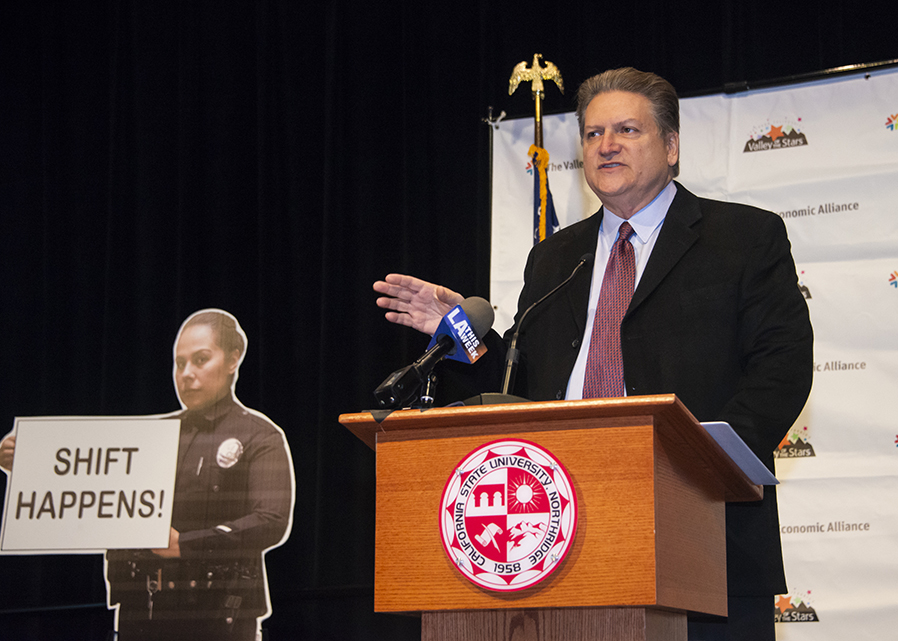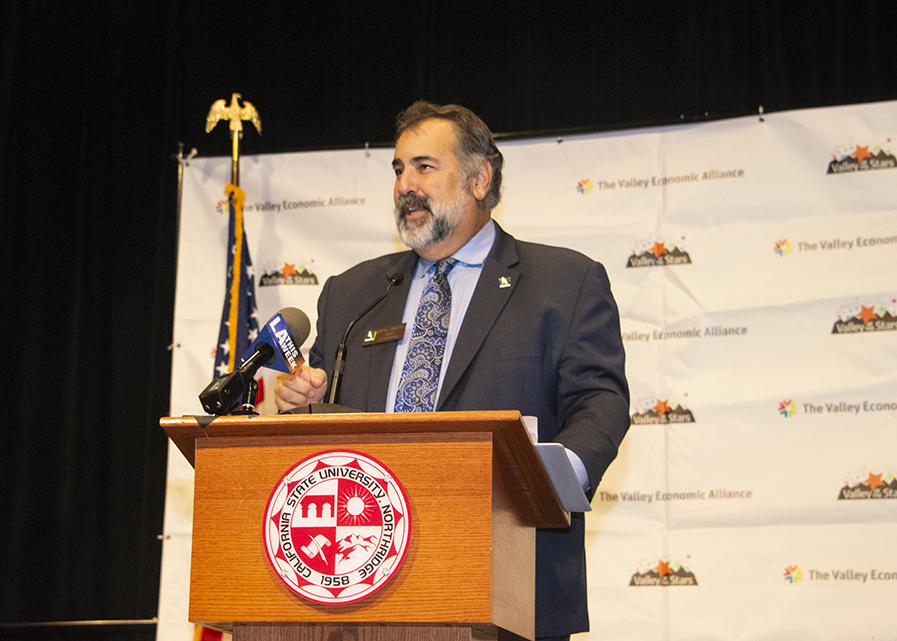“Are You Prepared? Shift Happens!” Conference at CSUN Focuses on Disaster Preparedness
In January 1994, one of the most devastating earthquakes in state history struck California State University, Northridge and the San Fernando Valley. To commemorate the 25th anniversary of the 1994 quake, The Valley Economic Alliance and CSUN’s College of Social and Behavioral Sciences and Valley Nonprofit Resources partnered to host a disaster preparedness conference called “Are You Prepared? Shift Happens!”
The conference, which took place Jan. 11, offered strategies to help business owners, home owners and individuals shift their attention and resources to emphasize the safety of people and property following natural disasters such as earthquakes, fires, floods and power outages.
CSUN President Dianne F. Harrison joined keynote speakers that included State Sen. Bob Hertzberg (D-Van Nuys) and City of Calabasas Mayor David Shapiro to discuss the importance of being proactive in emergency preparation.
“Living in Southern California, we know all too well the importance of emergency planning,” Harrison said. “Just last year, our region experienced some of the worst fires in California’s history, which caused widespread destruction. With the Northridge earthquake 25 years ago, CSUN and our surrounding community experienced the devastation earthquakes can bring, and why planning, resources, hard work and leadership are all needed to recover.”
A goal of The Valley Economic Alliance is to ensure the region is prepared for challenges during and after a natural disaster. The alliance is comprised of businesses, government, education and community organizations that work together to promote greater standards of living and economic vitality in the Valley. CSUN’s Valley Nonprofit Resources offers both information and services to strengthen the more than 5,600 nonprofit organizations in the San Fernando Valley.
Sessions at the conference provided advice for both individuals and organizations for staying safe during natural disasters. The tips included the standard “drop, cover and hold on” for individuals experiencing an earthquake, as well as big-picture advice for organizations, including detailed communication plans for employees, updating phone lists with employees’ home contact numbers and testing emergency plans.
In December, Shapiro had a front-row seat to the damage caused by the Woolsey Fire. He shared his city’s experiences with emergency planning and stories of the recent disaster.
“We lost nine homes, two apartment [buildings], one hotel and two city parks, and [implemented] a complete citywide evacuation for five days, but [experienced] no loss of life thanks to our tremendous first responders,” Shapiro said. “One of the things that are most important in our city is brush clearance. This helps firefighters buffer the effects of the fire and saves lives, pets and homes. The work was done by the many sheriffs, police officers and firefighter first responders who carried out a detailed emergency plan for the city.”
State Sen. Hertzberg asked how many business owners were present in the room during his address. Seeing dozens of hands raised, he said, “We often like to complain about the inefficiency of government, taxes and all the rest, but as Mayor Shapiro detailed the events of the fire, we see government working, your tax dollars working — people that spent 24-hour days making sure that safety was a No. 1 priority.”
In addition to natural disasters, the conference included discussions regarding man-made crises such as burglaries, home invasions and mass shootings. Captain Bryan Lium, commanding officer of the Los Angeles Police Department’s Devonshire Division, spoke about practical ways to help secure the safety of one’s business and home. He stressed the importance of keeping an emergency plan ready for each situation.
To end the conference, Stephen Jordan, CEO of the Institute of Sustainable Development, a leading expert in disaster recovery and community economic development, spoke about the realities of natural disasters and their impact. Jordan said that private and public organizations must foster greater interdependency and interconnectivity in order to better respond to natural disasters. He referred attendees to a planning guide made available by the Los Angeles Economic Development Corporation that included strategies for shoring up both customer information and physical buildings.
“What recent wildfires have shown us is that approaching the future the same we have in the past is just too costly, too painful and not good for anyone in our community,” Jordan said. “If a disaster strikes, we need to be worried about not only preparing emergency plans, but how we can reinvent our infrastructure so that if the same disaster strikes it won’t be as catastrophic as before.”




 experience
experience